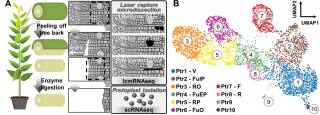Jan, 2023

Xylem, the most abundant tissue on Earth, is responsible for lateral growth in plants. Typical xylem has a radial system composed of ray parenchyma cells and an axial system of fusiform cells. In most angiosperms, fusiform cells comprise vessel elements for water transportation and libriform fibers for mechanical support, while both functions are performed by tracheids in other vascular plants such as gymnosperms. Little is known about the developmental programs and evolutionary relationships of these xylem cell types. Through both single-cell and laser capture microdissection transcriptomic profiling, we determine the developmental lineages of ray and fusiform cells in stem-differentiating xylem across four divergent woody angiosperms. Based on cross-species analyses of single-cell clusters and overlapping trajectories, we reveal highly conserved ray, yet variable fusiform, lineages across angiosperms. Core eudicots Populus trichocarpa and Eucalyptus grandis share nearly identical fusiform lineages, whereas the more basal angiosperm Liriodendron chinense has a fusiform lineage distinct from that in core eudicots. The tracheids in the basal eudicot Trochodendron aralioides, an evolutionarily reversed trait, exhibit strong transcriptomic similarity to vessel elements rather than libriform fibers. This evo-devo framework provides a comprehensive understanding of the formation of xylem cell lineages across multiple plant species spanning over a hundred million years of evolutionary history.